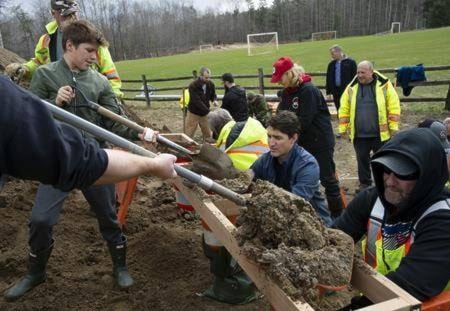OTTAWA — Prime Minister Justin Trudeau picked up a shovel Saturday to lend a hand with sandbagging efforts, as he and his two sons visited a west-end Ottawa community hit hard by rising floodwaters.
Trudeau was briefed by officials in charge of the fight against the flood at a community centre before filling sandbags and thanking those who came to the aid of local residents.
“Thank you for doing what you are doing,” Trudeau said as he and sons Xavier and Hadrien spoke with volunteers working around a large sandpile.
Not everyone appreciated Trudeau’s efforts to encourage others to help out flood-stricken families.
As he was shaking hands with military personnel and volunteers in Constance Bay, the riverfront village west of downtown Ottawa that has seen the worst flooding so far, a local resident confronted the prime minister to complain that his visit had slowed down sandbagging operations.
“You and your security are blocking the roads,” said the unidentified man.
“What you’re doing is insincere.”
The Prime Minister’s Office later said it had confirmed with the RCMP that traffic around the Constance and Buckham’s Bay Community Centre was not blocked for Trudeau’s visit.
It’s another anxious weekend for flood-weary communities in Eastern Canada, with rain in the forecast for an area stretching from cottage country north of Toronto all the way to the Acadian Peninsula.
Montreal, Ottawa and many smaller communities across the expansive flood zone have declared states of emergency, prompting the federal government to deploy hundreds of soldiers to help with sandbagging and other relief operations.
Despite a night that gave Ottawa and Gatineau, Que., a break from rain, water levels around the capital region are expected to rise half a metre higher than they did during a 2017 flood that was thought to have been a once-in-a-century event.
A morning report from the board that monitors levels in the Ottawa River says near Constance Bay, water levels are just shy of their 2017 levels and are forecast to rise another 47 centimetres. At a measuring spot near Parliament Hill, where paths and parking lots along the river are already underwater, the board forecasts a rise of another 75 centimetres before water levels peak on May 1.
Rising river levels forced the closure Saturday morning of a heavily travelled bridge onto the Island of Montreal. Quebec’s Transport Department announced it was closing the Galipeault Bridge, a western access point to Montreal along Highway 20.
The department said in a statement that the closure is for an indefinite period. Traffic is being diverted to another bridge farther north, but the department asked motorists to avoid the area.
A close eye is also being kept on a hydroelectric dam, on a tributary of the Ottawa River between Ottawa and Montreal, that’s at risk of failing. Water at the Chute-Bell dam has reached levels expected to occur every 1,000 years, but Hydro-Quebec says it’s confident the structure is solid.
Meantime, a bit of relief is in sight for flood-weary residents of southern New Brunswick, with the latest forecast calling for waters to slowly recede in most areas over the next five days.
Geoffrey Downey, a spokesman for New Brunswick Emergency Measures Organization, said while it’s raining across much of the province today, officials aren’t expecting a lot of precipitation.
He said the five-day flood forecast is for the Saint John River to be below flood stage in Fredericton, and down to flood stage in Maugerville, Oak Point and Saint John, by Thursday.
In southern Manitoba, the rising Red River has forced some road closures and a small number of evacuations but earlier predictions for major flooding between the U.S. border and Winnipeg haven’t come to pass.
